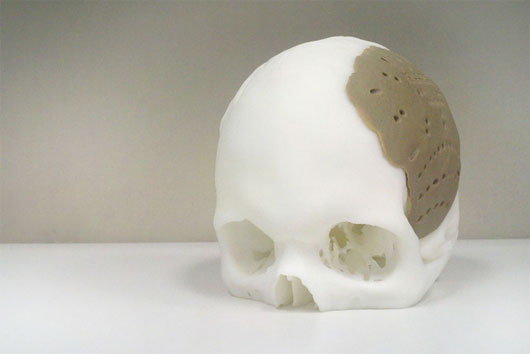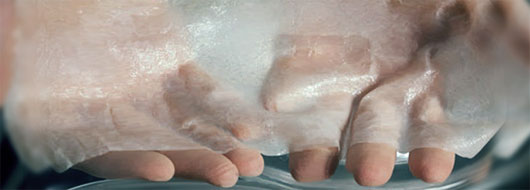Recreate parts of the body with 3D printing technology
3D printing technology is no stranger to us, but applying this technology to Medicine is still quite a new thing.
At the dawn of rapid prototyping technology, it is predicted that 3D printing technology will transform production, creating a revolution for consumers so that every family can have a printer. That's not quite the case, but like so many new technologies, rapid prototyping technology has found its place in a surprisingly different area of Medicine.
The following studies and projects represent some of the best examples of 'biological printing', or the use of computers to assemble biological materials using organic and heat-resistant thermoplastics. Here are examples of the most modern 3D printing technology.
1. Skull

Osteofab is a product manufactured by the Oxford Performance Materials Company (OPM) of the UK. OPM has started its business by selling a high-performance polymer commonly used in medical implants, a thermoplastic thermoplastic called polyetherketoneketone in its raw form. Over the years, the company has pioneered the application of materials, primarily through the production of additives. In February, an American patient was implanted with a skull patch approved by FDA. The skull is made of special materials and printed carefully to match 75% of his distinctive shaped skull.
2. Skin

There is a big problem with the new 'in' skin idea that is difficult to reproduce a special skin. Because our skin is very unique, thin and changeable. So it's hard to complete an exact copy. Research in this area has a lot of interesting things that within a short paragraph we cannot discuss it all, however, there are two highlights, namely: Scientist James Yoo made direct printing. on the skin of the burn victim, this process is supported by a part from the Ministry of Defense. Meanwhile, scientists at the University of Liverpool are using a carefully calibrated 3D scanner to capture current samples of the specimen, which helps them print a more accurate patch.
Research is still underway, the team plans to create a 'skin database' of the samples taken.
3. Nose and ears

The process of reproducing fake ears, nose and chin is often very painful, costly and time consuming for both patients and doctors. Tom Fripp, an industrial designer from the UK, has partnered with Sheffield University scientists to print 3D at a lower cost and easier to produce facial prostheses. This process involves 3D face scanning of patients, partial modeling and use of pigments, silicom medical standards for printing. Another advantage is that when patients replace those prostheses, they can be reprinted at a cheaper price.
4 eyes

Previously, Fripp and his team at Sheffield published the results of eye examination. The process of making fake eyes is expensive because they are drawn by hand and usually take several months to complete one eye. Fripp printers can print 150 eyes / h in turn with full details such as iris, size and blood vessels. It is also customizable based on the needs of each patient.
5. Battery provides energy for tissue

Scientists are trying to produce batteries small enough to power implants. The engineering team at Harvard said that 3D battery printing is as small as a grain of sand."The researchers created an ink for anodes from nanoparticles of a lithium metal oxide compound, and an ink for cathodes from nanoparticles of another compound," the team explained . The printer sends the inks to the teeth of two golden combs, creating a tight alternating stack of anodes and cathodes. The researchers then packaged the electrodes in a small container and filled it with an electrolyte solution to complete the battery. In the end, they can power battery implants. "
6. Bone

3D print implants like jaw bone have appeared for several years. But only a few researchers are testing real bone replacement. For example, scientist Kevin Shakeshaff at Nottingham University developed a biological printer that produces a polylactic acid truss and alginate glue, which is then encased in adult stem cells. According to Forbes, these substances will be dissolved and replaced by newly developed bones within about 3 months.
7. Blood vessels and cells

We can print body parts but there is a problem with production tissues that create a circulatory system that works with it. Gunter Tovar, a German scientist at the Fraunhofer Institute of Biotechnology and Technology, is leading a project called BioRap that says the project aims to develop 3D printed blood vessels using a combination of total polymer. fit with biological molecules. Print systems are being tested on animals, researchers are still not ready to experiment on humans, but they can finally bring 3D printing technology into organ transplants.
- Organ transplants with 3D printing technology
- Using 3D technology to recreate conjoined twins body parts
- Biological ink breakthrough 'in' human body parts
- We will recreate one of the most difficult parts to replace the body
- Dubai wants to become a city built with 3D printers
- Unbelievable applications of 3D printing technology
- 3D biological printing, pharmaceutical industry revolution
- Body parts are gradually being mass produced
- ESA is studying 3D bone and skin printing to help save accidents in space
- Extremely toxic products from 3D printers
- China successfully implanted 3D blood vessels into monkeys
- Artificial hand from 3D printing technology
 Green tea cleans teeth better than mouthwash?
Green tea cleans teeth better than mouthwash? Death kiss: This is why you should not let anyone kiss your baby's lips
Death kiss: This is why you should not let anyone kiss your baby's lips What is salmonellosis?
What is salmonellosis? Caution should be exercised when using aloe vera through eating and drinking
Caution should be exercised when using aloe vera through eating and drinking